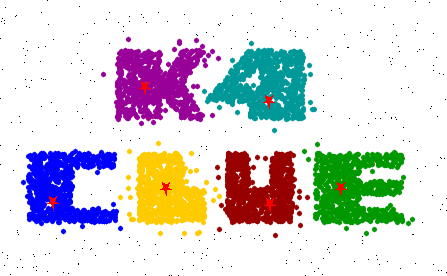The CLUE algorithm (here the gitLab repo)
was adapted to run in the Gaudi software framework and to support EDM4hep data format for inputs and outputs.
Currently only the version of the algorithm in C++ is available, the GPU version will added soon directly from the original standalone repository.
The following setup is considering an lxplus machine.
# source key4hep environment
source /cvmfs/sw.hsf.org/key4hep/setup.sh
# then setup this project
git clone --recurse-submodules https://github.com/key4hep/k4Clue.git
cd k4Clue
cmake -S . -B build
cmake --build build
# if installation is needed
mkdir install
cd build/ ; cmake .. -DCMAKE_INSTALL_PREFIX=../install; make installCLUE needs three parameters as input:
dcis the critical distance used to compute the local density;rhocis the minimum local density for a point to be promoted as a seed;outlierDeltaFactoris a multiplicative constant to be applied todc.
(
In the original article and implementation, four parameters were needed (dc, rhoc, deltao and deltac):
deltaois the maximum distance for a point to be linked to a nearest higher point.deltacis the minimum distance for a local high density point to be promoted as a Seed. )
CLUE uses a spatial index to access and query spatial data points efficiently. Thus, a multi-layer tessellation is created which divides the 2D space into fixed rectangular bins. The limits and size of the tessellated space is defined by the user.
An example can be found in LayerTilesConstants.h. A step-by-step guide to introduce a new detector can be found in another readme.
If the projects compiles without errors, you can go run the CLUE algorithm by
cd build/
./run gaudirun.py ../gaudi_opts/clue_gaudi_wrapper.pyCLUE parameters and input/output file name are contained in gaudi_opts/clue_gaudi_wrapper.py.
The input files are using the EDM4HEP data format and the ECALBarrel and ECALEndcap CalorimeterHit collections are required.
The output file output.root contains CLUEClusters (currently also transformed as CaloHits in CLUEClustersAsHits).
A simple recipe to run k4CLUE as part of the CLIC reconstruction chain can be found here.
If you encounter any error when compiling or running this project, please contact:
- Erica Brondolin, erica.brondolin@cern.ch
